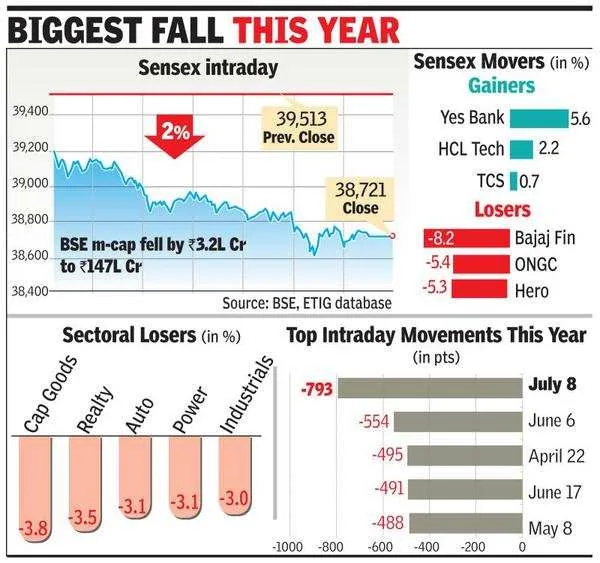A Black Day for Indian Investors as Nifty, Sensex, and Bank Nifty Plunge as Indian stock market crashes 4% due to new tariff anouncment. The Indian stock market witnessed a massive crash today, triggered by a global shockwave from the United States. After US President Donald Trump’s announcement of aggressive tariffs, Indian markets plunged, erasing over ₹19 lakh crore in investor wealth.
The Nifty 50 dropped by 750 points (3.25%) to close at 22,161, while the Sensex tanked 2,226.70 points (3%), ending at 73,137.90. The Bank Nifty also witnessed a significant fall, dropping 1,642.80 points (3.19%) to settle at 49,860.10.
At its lowest intraday point, the BSE Sensex crashed 3,939 points to touch 71,425, marking one of the worst days for Dalal Street since the COVID-19 pandemic crash.

Why Did the Indian Stock Market Crash?
1. US Tariff Shock
The primary reason behind this market turmoil is President Donald Trump’s new tariff policy, which imposes heavy reciprocal tariffs on several countries. This move created panic in global financial markets, pushing investors toward safer assets like government bonds.
2. Global Market Panic
Following the announcement, Foreign Institutional Investors (FIIs) and Domestic Institutional Investors (DIIs) began withdrawing investments, fearing long-term trade disruptions.
3. India’s Diplomatic Stand
According to Reuters, countries like India, Japan, Mexico, and South Korea are negotiating with the US instead of retaliating. However, uncertainty around diplomatic outcomes has further spooked investors.
Other Major Factors Behind the Market Crash
Apart from the US tariff policy, several domestic and global factors contributed to today’s crash:
🔹 Government Policy Impact
New foreign trade policies, especially from the US, have a direct impact on global markets. India, being a major trade partner, faces the brunt of these sudden changes.
🔹 Supply and Demand Disruptions
Tariffs create imbalances in global supply chains, leading to price hikes and lower trade volumes, affecting multiple sectors including manufacturing, tech, and FMCG.
🔹 Rising Inflation Fears
Higher tariffs lead to increased costs of imports, which in turn drive inflation. This puts additional pressure on central banks and can lead to interest rate hikes—further affecting stock valuations.

What’s Next for Indian Markets?
While today’s crash has shaken investor confidence, it’s important to understand that market cycles are natural, especially in response to global geopolitical and economic shocks. The path forward for Indian markets will largely depend on a mix of diplomatic actions, global cues, and policy responses.
Key Factors to Watch:
- India-US Talks: Any relief or concessions from the US could help stabilize sentiment.
- Global Market Cues: Clearer guidance from the US on tariffs may reduce uncertainty.
- RBI’s Response: The central bank’s actions on interest rates will be crucial if inflation rises.
- FII Movement: Continued selling by foreign investors could drag markets, but bargain buying may follow.
What Should Investors Do?
- Avoid panic selling and stick to long-term goals.
- Reassess portfolios and focus on quality stocks.
- Keep some liquidity for possible buying opportunities.
- Stay updated, but don’t let fear drive decisions.
Global Impact after Tariffs

The Indian stock market wasn’t alone in this tumble. Major global indices also faced heat after the US tariff shock:
- Dow Jones dropped by 1.8%
- FTSE 100 (UK) fell 2.1%
- Nikkei 225 (Japan) declined 2.4%
The ripple effect of US tariffs caused investors across the globe to pull out of equities and shift towards safer assets like gold and government bonds.
“The tariff move has spooked markets globally. Investors are fearing a return to trade war-era volatility,” said Ankit Agarwal, Market Strategist at BloomFin Advisory.
Sector Dependent Impact
Several sectors bore the brunt of the crash. Here’s a quick breakdown:
Sector % Drop Today Banking & Finance -3.2% IT & Tech -2.8% FMCG -2.1% Metals & Mining -3.5% Auto Sector -2.9% Sectors dependent on imports and exports—especially metals, auto, and tech—were hit hardest due to potential supply chain disruptions and rising costs.
Today’s crash is a major shakeup, but not the end of the road. Markets have always recovered from shocks—whether it was COVID-19, the 2008 crash, or demonetization. For the latest stock market updates, economic news, and financial insights, stay tuned to Toofani Khabar!
More Toofani Reads:
Gukesh Dommaraju Age,Height, Awards, Net worth, family and More 2024
Top 10 International Destinations from India
20 Most Popular Shiva Temple in India





